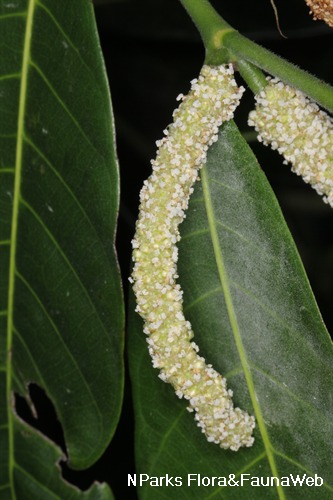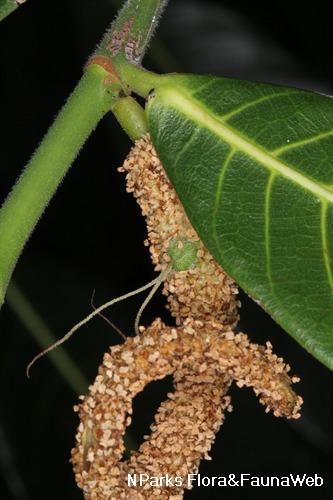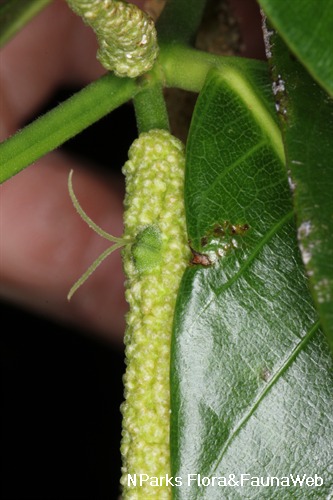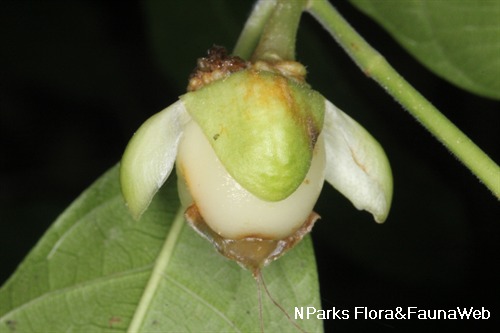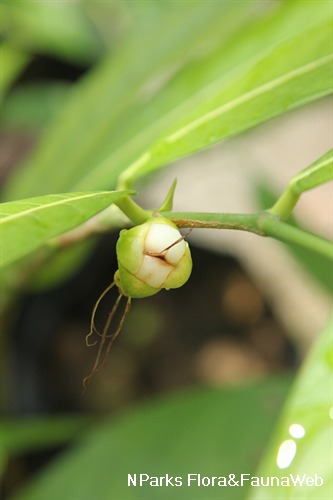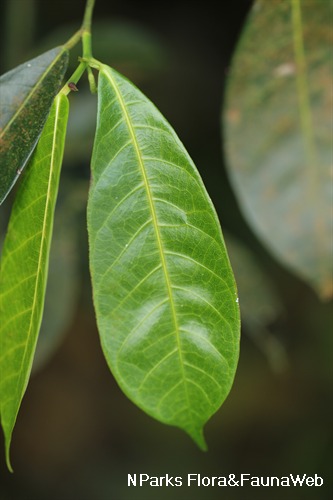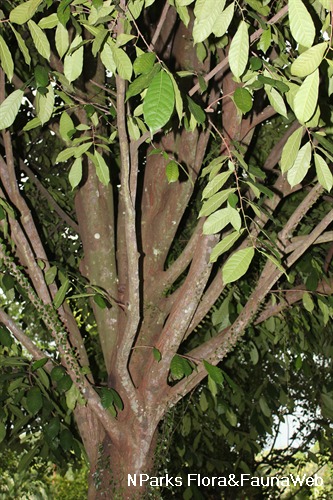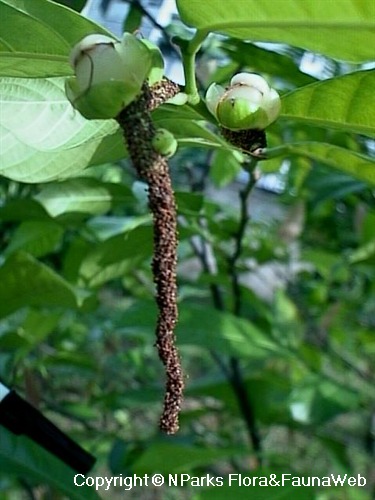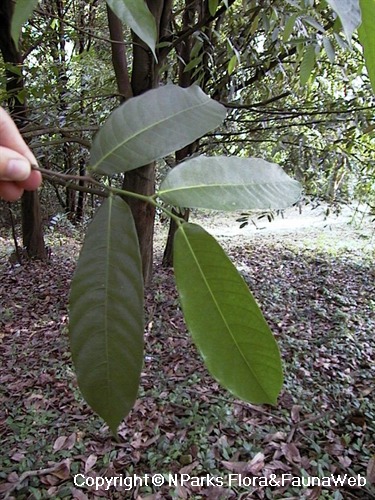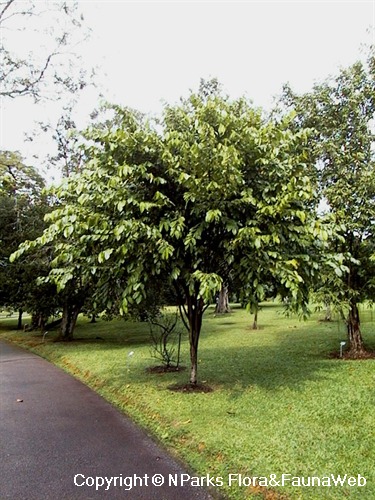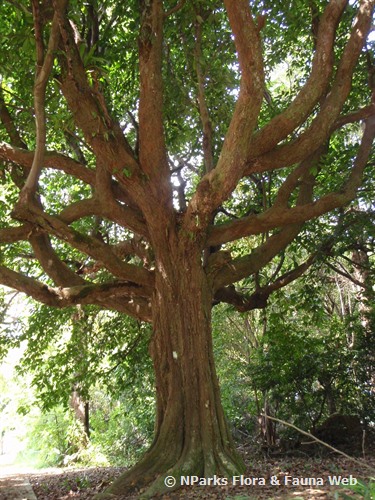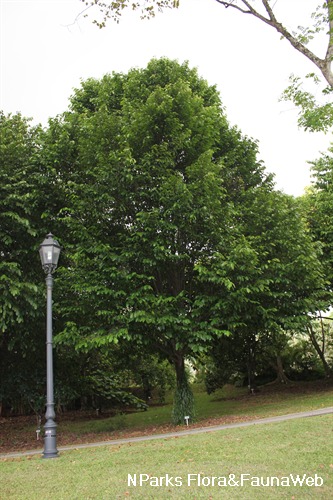
Back
Sloetia elongata (Miq.) Koord.
| Family Name: | Moraceae |
| Synonyms: | Streblus elongatus (Miq.) Corner, Artocarpus elongatus Miq. |
| Common Name: | Tempinis, Tampines Tree, Tamping, Kepinis |
Name
Classifications and Characteristics
| Plant Division | Angiosperms (Flowering Seed Plants) (Dicotyledon) |
|---|---|
| Plant Growth Form | Tree (Big (>30m)) |
| Lifespan (in Singapore) | Perennial |
| Mode of Nutrition | Autotrophic |
| Plant Shape | Rounded |
| Maximum Height | 35 m |
Biogeography
| Native Distribution | From Sumatra, through Malaysia and Singapore, to Sulawesi |
|---|---|
| Native Habitat | Terrestrial |
| Preferred Climate Zone | Tropical |
| Local Conservation Status | Native to Singapore (Least Concern (LC)) |
Description and Ethnobotany
| Growth Form | It is a tree up to 35 m tall, with a rounded crown. |
|---|---|
| Crown | It has a rounded crown. |
| Foliage | Its alternate, stalked leaves have thinly leathery leaf blades that are elliptic or drop-shaped, 6–38 by 1.5–16 cm, with uneven bases and pointed tips, and have 10–20 pairs of side veins. |
| Flowers | The plant is monoecious, producing male and female flowers on the same individual. The flowers are found on 3–20 cm long flower clusters which develop at the leaf axils. The male flowers are numerous, small, and appeared whitish. The female flowers are larger, occur in clusters of 1–5, and each look like a green-ball borne on the flower cluster, with two arms sticking out of it. |
| Fruit | The fruit is whitish, round or ellipsoid, 1–1.3 cm long, and is enclosed in the greenish female flowers. Its seeds are 0.6 cm across and pale brown. |
| Habitat | It grows in primary and secondary lowland and hill forests, up to 800 m altitude. It occurs locally in Bukit Timah Nature Reserve, Central Catchment Nature Reserve, Pulau Tekong, Pulau Ubin, and Sentosa Island. |
| Associated Fauna | Its flowers are insect-pollinated. Its seeds and fruits are said to be eaten and dispersed by monkeys. |
| Cultivation | It can be propagated by seed or cuttings. |
| Etymology | Greek streblus, crooked; Latin elongatus, lengthened, probably referring to the flowering stalks of the plant |
| Ethnobotanical Uses | Timber & Products: The plant is harvested for its timber, which is heavy, strong, and durable.
Cultural / Religious: The eastern housing estate in Singapore, Tampines, is named after this tree, probably due to the abundance of it at that area in the past. Heritage Tree : There are currently two individuals of Streblus elongatus listed as Heritage Trees in Singapore. One can be found on St. John's Island, while the other at Changi. To find out more about these trees, please visit the Heritage Tree Register. |
Landscaping Features
| Landscaping | It may be suitable for parks and roadsides. The tree has an attractive round crown that provides shade. |
|---|---|
| Desirable Plant Features | Ornamental Form |
| Landscape Uses | General, Suitable for Roadsides, Parks & Gardens, Coastal, Shade Providing Tree / Palm |
Fauna, Pollination and Dispersal
| Pollination Method(s) | Biotic (Fauna) |
|---|---|
| Seed or Spore Dispersal | Biotic (Fauna) |
Plant Care and Propagation
| Light Preference | Semi-Shade, Full Sun |
|---|---|
| Water Preference | Moderate Water |
| Plant Growth Rate | Moderate |
| Rootzone Tolerance | Moist Soils, Well-Drained Soils, Fertile Loamy Soils |
| Maintenance Requirements | Low |
| Propagation Method | Seed, Stem Cutting |
Foliar
| Foliage Retention | Evergreen |
|---|---|
| Mature Foliage Colour(s) | Green |
| Mature Foliage Texture(s) | Leathery |
| Foliar Shape(s) | Non-Palm Foliage (Obovate, Elliptical) |
| Foliar Venation | Pinnate / Net |
| Foliar Margin | Entire |
| Leaf Area Index (LAI) for Green Plot Ratio | 4.0 (Tree - Dense Canopy) |
Floral (Angiosperm)
| Flower & Plant Sexuality | Unisexual Flowers , Monoecious |
| Flower Colour(s) | White |
|---|
| Flower Grouping | Cluster / Inflorescence |
| Flower Location | Axillary |
| Inflorescence Type | Catkin |
Fruit, Seed and Spore
| Mature Fruit Colour(s) | White |
|---|---|
| Fruit Classification | Simple Fruit |
| Fruit Type | Fleshy Fruit , Non-Accessory Fruit |
Image Repository
Others
| Master ID | 1852 |
|---|---|
| Species ID | 3145 |
| Flora Disclaimer | The information in this website has been compiled from reliable sources, such as reference works on medicinal plants. It is not a substitute for medical advice or treatment and NParks does not purport to provide any medical advice. Readers should always consult his/her physician before using or consuming a plant for medicinal purposes. |

